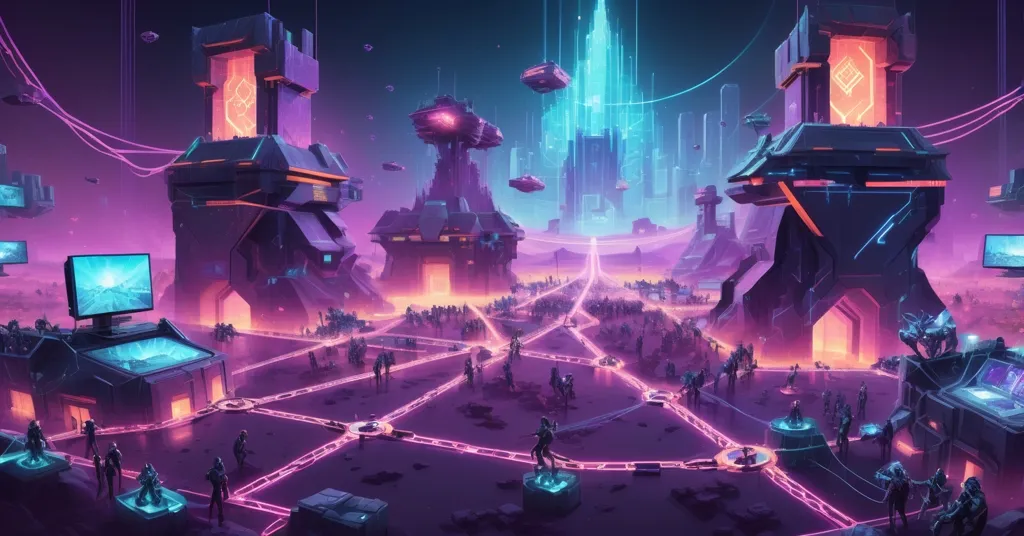Battlefield 6 Season One Launches: Why Decentralization Is the Real Game-Changer

Battlefield 6 Season One Drops, But the Real Fight Is for Decentralization
EA Games has unleashed Season One for Battlefield 6, a massive update packed with new maps, weapons, and modes starting October 28. But at “Let’s Talk, Bitcoin,” we’re not here to camp on virtual battlefields—we’re more interested in the war for financial freedom. So, why cover a video game? Simple: EA’s iron grip on content and servers is a glaring example of centralized control, the exact kind of system Bitcoin and blockchain tech aim to dismantle. Let’s break down this gaming update and pivot to what matters—how decentralization could game-change industries far beyond digital warfare.
- Season One Snapshot: Battlefield 6’s first major update launches October 28 with phased content like maps and tactical modes.
- Centralized Power: EA’s tight control over updates mirrors the gatekeepers crypto seeks to overthrow.
- Decentralized Vision: Blockchain could redefine gaming with player ownership and freedom—let’s explore how.
Battlefield 6 Season One: The Quick Rundown
Battlefield 6, developed by Battlefield Studios and published by EA Games, has rolled out its Season One update, marking the first significant content drop since the game’s debut. Kicking off on October 28, this season unfolds in three phases to keep players engaged over months. Phase One, dubbed “Rogue Ops,” introduces the Blackwell Fields map—a sprawling California air base with oil wells and open terrain ideal for large-scale chaos—and a 4v4 tactical mode, which pits small teams of four against each other in strategy-focused combat. Phase Two, “California Resistance,” lands on November 18 with the Eastwood map, inspired by Southern California’s ritzy neighborhoods for tight, close-quarters battles, alongside an 8v8 Sabotage mode built for disruption. Finally, Phase Three, “Winter Offensive,” hits December 9 with a frosty winter-themed map and a seasonal Ice Lock event.
Beyond new playgrounds, Season One packs fresh gear like the SOR-300 Carbine, a versatile rifle for varied combat, and other additions including sniper rifles and vehicles. EA’s strategy here is clear: stagger the content to maintain hype, a classic move in today’s live-service gaming model. With over 7 million copies sold in its first week—a record for EA’s shooter lineup—the stakes are high. Yet, not all is smooth; early leaks of PS5 physical copies surfaced on Reddit via a European retailer, suggesting pre-launch server testing. Whether full online features were live pre-release remains unclear, but it’s a reminder of piracy headaches in gaming. Storage-wise, expect a chunky 68GB on PS5 and Xbox Series X, or a slimmer 39GB on Xbox Series S. For more details on the launch, check out the full update on Battlefield 6’s Season One content.
Centralized Control: EA’s Iron Fist Playbook
Let’s cut through the fluff—Battlefield 6’s success isn’t the story here. It’s EA’s chokehold on every pixel of this game that grabs attention. From deciding when new maps drop to controlling server access, EA operates as the supreme overlord of this digital realm. Players? They’re just tenants, shelling out cash for a experience dictated by corporate whim. If EA pulls the plug on servers tomorrow, your hard-earned progress vanishes faster than a shitcoin after a pump-and-dump. This is centralized power at its ugliest—a single entity calling all shots, not unlike the traditional banking systems that hoard control over your money.
Compare that to Bitcoin’s ethos: no middleman, no gatekeeper, just peer-to-peer freedom. EA’s drip-feed of content might keep gamers hooked, but it’s a stark contrast to what decentralization promises—systems where users, not suits in boardrooms, hold the reins. Sure, EA’s promising regular patches and server stability, but leaks of physical copies already hint at cracks in their fortress. Sound familiar? It’s not far off from legacy financial institutions fumbling security while swearing they’ve got your back. Centralized systems, whether in gaming or finance, are built on fragile trust—and that’s a bet many of us aren’t willing to take anymore.
Decentralized Gaming: Crypto’s Potential to Flip the Script
Now, let’s pivot to the good stuff. Imagine a gaming world where you’re not just a player but an owner. Blockchain technology makes this possible through decentralized platforms where assets aren’t locked behind a publisher’s paywall—they’re yours to keep, trade, or sell. Non-Fungible Tokens, or NFTs, are a key piece here. These are unique digital items, verified on a blockchain, that can represent in-game gear, skins, or even virtual land. Unlike EA’s ecosystem, where your shiny new carbine lives or dies by their servers, NFT-based assets stick with you as long as the blockchain exists.
Real-world examples already prove this isn’t sci-fi. Take Axie Infinity, a blockchain game where players earn cryptocurrency by battling digital creatures called Axies, which are NFTs. At its peak, some players in developing countries turned this into a full-time gig, earning more than local wages. Or look at The Sandbox, a virtual world where users buy, customize, and monetize land plots as NFTs, creating a player-driven economy. These aren’t perfect—Axie faced a massive $600 million hack in 2022, exposing security risks—but they showcase a shift toward empowerment. Ethereum often powers these platforms due to its smart contract capabilities, enabling complex game logic. Yet, as Bitcoin maximalists, we’d argue Bitcoin’s Lightning Network could handle microtransactions for gaming, offering fast, cheap payments as a settlement layer, even if it lacks Ethereum’s flexibility.
Contrast this with Battlefield 6’s model. EA owns everything; you’re just renting. A decentralized Battlefield could let you trade maps or weapons as NFTs on open marketplaces, with earnings in Bitcoin or another crypto. No corporate middleman skimming profits—just pure, player-to-player value. Even better, decentralized servers (think peer-to-peer hosting on blockchain protocols) could mean no single point of failure. If EA’s servers crash, you’re screwed. In a decentralized setup, the game lives as long as the community does. This isn’t just gaming utopia; it’s the same principle driving crypto’s fight against centralized finance—power back to the people.
Playing Devil’s Advocate: Is Blockchain Gaming Overhyped?
Before we get too starry-eyed, let’s pump the brakes. Blockchain gaming sounds like a libertarian wet dream, but it’s not without warts. For starters, the space is a wild west of scams—think NFT projects promising “revolutionary” games that vanish after minting millions, leaving players with worthless jpegs. High gas fees on Ethereum, often needed to mint or trade in-game assets, can make small transactions laughably expensive, alienating casual gamers. And let’s not ignore the environmental jab—proof-of-work chains (though less so with Ethereum’s shift to proof-of-stake) get flak for energy use, a critique Bitcoiners know all too well.
Then there’s the question of adoption. Most gamers don’t give a damn about owning digital assets—they just want to frag enemies without a wallet setup tutorial. Will AAA giants like EA ever embrace blockchain without gutting its decentralized soul for profit? Probably not. They’d likely slap NFTs into microtransactions, creating speculative bubbles rather than true ownership. And while Bitcoin could theoretically underpin gaming payments, its volatility—$60K one day, $40K the next—makes it a shaky in-game currency without stablecoin crutches. So, while the potential for disruption is massive, we’re miles from a world where Battlefield 6’s millions play on a blockchain. Optimism? Sure. Blind hype? Hell no.
The Real Battlefield: Freedom Through Crypto
Battlefield 6’s Season One might dominate gaming headlines with its shiny maps and record-breaking 7 million sales, but the true fight isn’t on Blackwell Fields. It’s in the push for a world where control isn’t hoarded by the EAs or the big banks of the world. Bitcoin and blockchain tech stand as weapons in this war, offering a future of privacy, ownership, and freedom—whether it’s trading digital assets in a game or moving value without a banker’s permission. EA’s centralized empire is a reminder of why we champion decentralization. The next update worth getting hyped for isn’t a winter map; it’s the next step in dismantling systems that keep power from the many.
Key Questions and Takeaways
- What’s the deal with Battlefield 6 Season One?
It’s a major update starting October 28, rolling out in three phases with new maps like Blackwell Fields, weapons like the SOR-300 Carbine, and modes like 8v8 Sabotage, backed by EA’s record 7 million sales in a week. - Why does EA’s control matter to crypto fans?
EA’s centralized grip on content and servers mirrors traditional finance’s gatekeeping, highlighting why Bitcoin and decentralization aim to return power to users over corporations. - How can blockchain redefine gaming?
Through NFTs for player-owned assets and decentralized platforms like Axie Infinity or The Sandbox, gamers could trade items or earn crypto, free from corporate control, using networks like Ethereum or even Bitcoin’s Lightning for payments. - What are the risks of blockchain gaming?
Scams, high transaction fees on chains like Ethereum, and low mainstream adoption pose hurdles, plus the risk of gaming giants co-opting NFTs for profit over true decentralization. - Where does Bitcoin fit in this vision?
While altcoins like Ethereum dominate gaming due to smart contracts, Bitcoin could serve as a secure payment layer via Lightning Network for in-game transactions, aligning with our maximalist push for its dominance.



